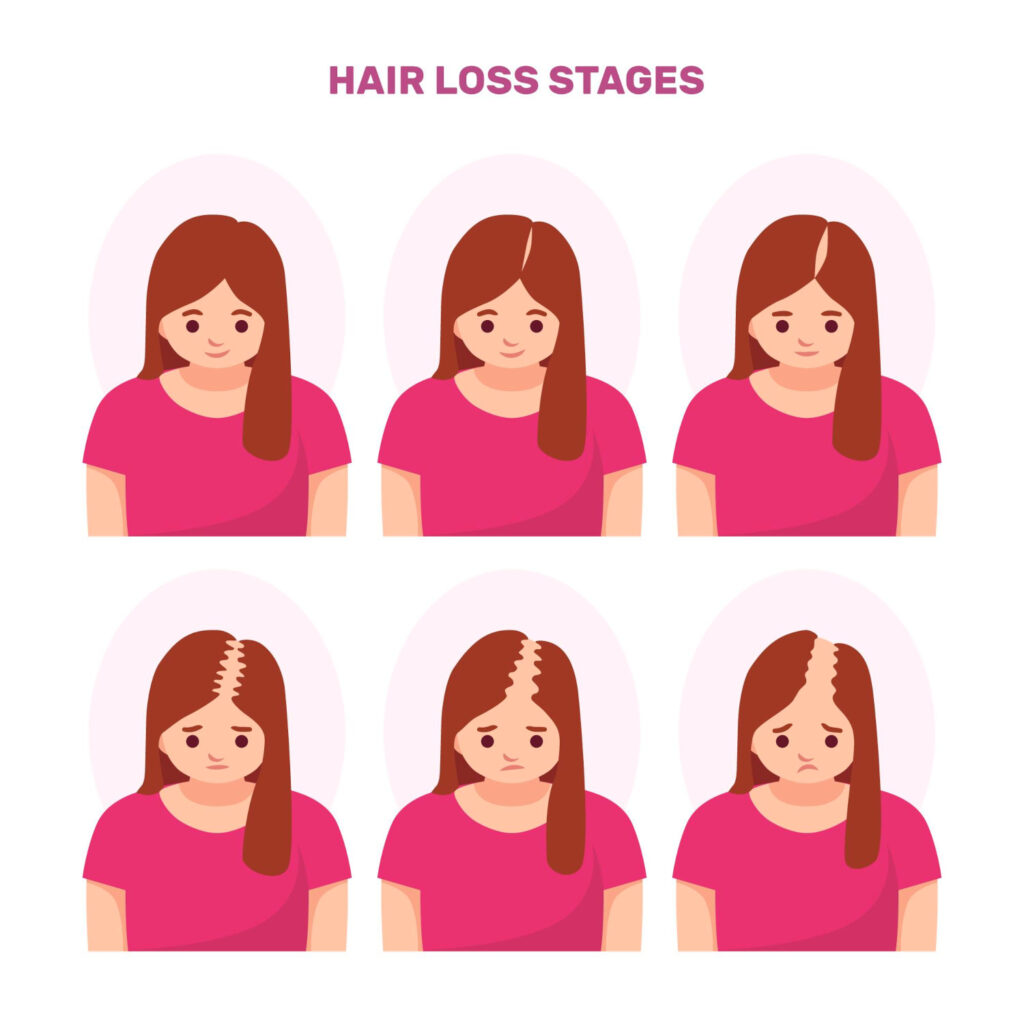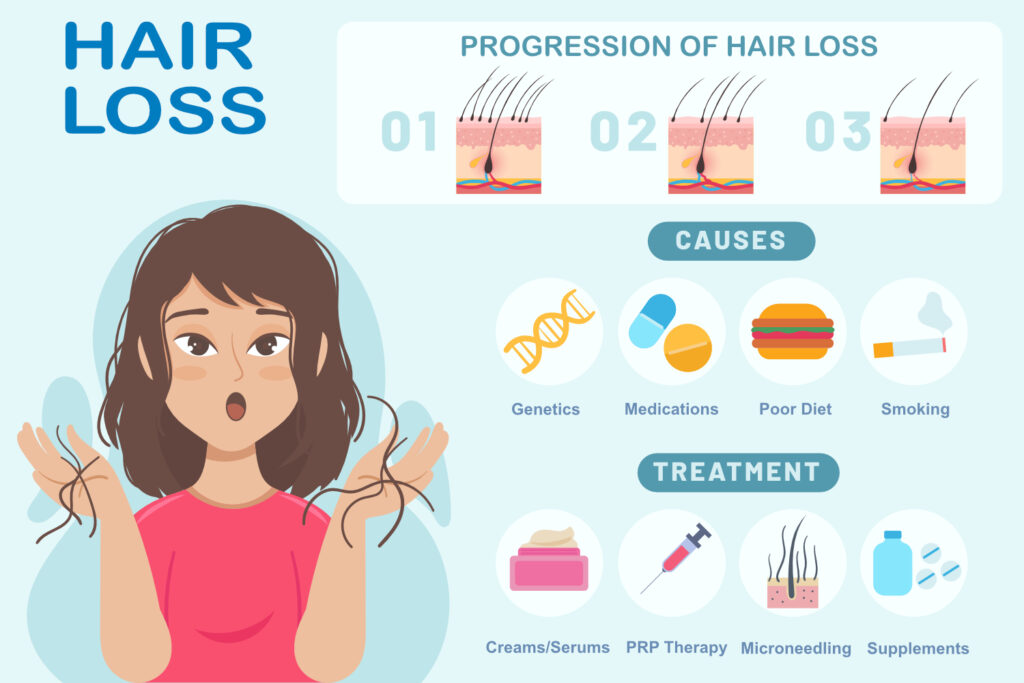Are you losing a lot of hair these days? Perhaps your hair is falling out while showering or combing your hair? Is your hair falling out in clumps throughout the day? Or is your hair partition becoming wider? Maybe you have noticed that your ponytail is thinner these days? You may be having either of the two most common causes of hair fall/hair loss in females – Female Pattern Hair Loss (FPHL) and Hair Shedding (Telogen Effluvium). Both these conditions affect millions of women.
FPHL is actually the most common cause of hair loss in females. Usually, FPHL begins when a woman is in her 40s. However, it can begin earlier for some women. FPHL is a progressive condition which means that women tend to continue losing hair. But unlike men, women do not lose all of their hair. Instead, the parting often gets wider. Hair near the temples may also recede in some cases. Without treatment, some women eventually develop widespread thinning.

Treatment can prevent hair loss in females from worsening and help women regrow their hair but the best results happen only when it is started at the first sign of hair loss.
Hair Shedding (also known as Telogen Effluvium) is more rapid wherein there is temporary hair loss due to the excessive shedding of telogen hair (hair in resting phase) after some illness, stress or deficiency. However, there may not be any visible bald spots and the hair tends to regrow in a few month’s time.
How can I tell if I have female pattern hair loss?
It’s best to make an appointment to see a dermatologist. Dermatologists are the experts in diagnosing the cause of hair fall and treating hair loss. A dermatologist can tell you whether it’s FPHL or something else that is causing your hair loss. Other causes of hair loss can look like FPHL, so it’s important to rule out those causes.
How can I tell if I have telogen effluvium or diffuse hair fall?
To know more about the most common causes of hair fall, check out Top 10 Causes of Hair Fall.
| Condition | Female Pattern Hair Loss | Hair Shedding |
|---|---|---|
| Medical Name | Androgenic Alopecia or Androgenetic Alopecia | Telogen Effluvium |
| Age of Onset | Usually 30-40. But nowadays, it begins in the early 20s | Can occur at any age |
| Affected Areas | Frontal and parietal (sides) of the scalp. Hair density is usually preserved in the back of the scalp and sides. Thickness is also preserved in the frontal hairline. | Whole scalp is affected. |
| What to look for | When styling the hair, the central “part” becomes wider over time, making more and more scalp visible when the hair is parted. | Sudden onset of hair fall from the entire scalp. It may lead to the appearance of bald spots if severe hair fall occurs. Clumps of hair fall out together. |
| Cause | Mainly genetics | After any illness, nutritional deficiency, pregnancy, stress, medicines, etc. |
| Treatment | Minoxidil (2-5%) | Anti-Hair Fall serum, supplements etc. Usually resolves in a few months |
What causes female pattern hair loss?
FPHL is primarily a genetic condition that causes progressive hair loss in females. Click here to know about the causes of FPHL which is the type of Androgenic Alopecia.
How do dermatologists treat female pattern hair loss?
The most commonly prescribed medicine for FPHL is minoxidil which still remains the gold standard for treating hair loss in females. You can read about this hair growth medicine and how to use it in – All About Minoxidil.
If you want to know all the treatment options available for hair loss in females then check out the treatment of FPHL here.
When will I see results? Hair grows slowly, so it takes time to see results. You’ll need to use minoxidil continuously for at least 6 months to see the results. If this medication works for you, you’ll need to use it every day to continue getting results. When you stop applying minoxidil, the hair that grew because of minoxidil will gradually begin to fall out and your hair loss can continue.
Prescription medications: Your hair specialist can prescribe some medications which have proven to be effective in helping women with FPHL grow hair and prevent FPHL from worsening. These include:
- Spironolactone.
- Finasteride
- Flutamide
- Dutasteride
With any medication, side effects are possible. Ask your dermatologist about possible side effects that you might experience while taking one of these medications.
When will I see results? If your dermatologist prescribes one of these medications, you’ll need to take it for at least 6-12 months to see good results. Like minoxidil, once you stop taking a prescription medication, you may lose the hair which grew. This may happen in about three to four months.
Women who are pregnant or plan to become pregnant should not take prescription hair-loss medicines. Dermatologists recommend that all pre-menopausal women use birth control while taking one of these prescription medications.
Hair transplant: It has been used to treat hair loss in men for a long time and may be an option for some women with FPHL. Today, most hair transplants look completely natural. Not everyone is a good candidate for a hair transplant though. If the hair on your scalp is sparse all over, you may not have enough healthy hair to transplant. Consult your hair specialist to know more about hair transplant.
Are there other treatment options for FPHL?
Women want innovative treatments for FPHL. To meet this need, researchers continue to look for new ways to stimulate hair growth and stop hair breakage. Other treatments that you may find for FPHL include the following.
Redensyl: This is a newer formulation that acts as regenerative medicine and targets the hair follicle stem cells, called the outer root sheath cells. Hair follicle stem cells play a big role in hair growth and are critical in initiating the anagen phase of the hair cycle (growth phase). And while it triggers the growing phase of hair growth, it also works to prevent the telogen phase (resting phase), meaning your hair has a longer period of growth before that follicle rests again. In this way, it helps your hair follicles favour growth over loss, helping to increase the overall number of hairs on your head, as well as the quality and length of those hairs.
Platelet-rich plasma therapy (PRP): This therapy uses your own blood. The blood is drawn and placed into a machine that separates the blood into its different components. The platelets, which are a type of blood cell containing various growth factors, are treated and injected into your scalp. This helps stimulate your cells to grow hair.
Lasers: The FDA has approved laser combs, helmets, and other devices, which are available without a prescription, to treat hair loss at home. These devices emit a low level of laser light that may help stimulate new hair growth. A few studies show that this can be effective for treating FPHL.
Stem cells: Using stem cells to treat FPHL is still in the experimental stages.
Supplements: Many supplements, including biotin and folic acid, are said to help grow and thicken hair. In studying these different supplements, the findings have been mixed. In most studies, the supplements had no effect on hair growth and thickness. In one study, however, 120 healthy women had thicker hair and less hair loss after taking specific omega-3 fatty acids, omega-6 fatty acids, and antioxidants. They took this combination for six months. If these results can be repeated in other studies, we’ll have some evidence to recommend taking these supplements.
You will find many supplements that promise to regrow hair. Before taking any of these, it’s best to check with your dermatologist. Some supplements can interact with medications. Your dermatologist can also tell you whether we have any evidence to show that the supplement helps regrow hair.
Hair loss shampoos/oils/serums: These products tend to do one of the following.
- Help your hair hold moisture, which makes hair look fuller and thicker.
- Lessen breakage, which can reduce thinning.
While commercial hair loss products may do the above, they cannot regrow hair or prevent hair loss from worsening.
A dermatologist’s diagnosis is best before treating hair loss
You can find a dermatologist in your area by going to Find a Dermatologist.
Key points
- See a dermatologist to check if you have FPHL, and to rule out other conditions like diffuse hair fall and telogen effluvium, which may be causing your hair loss.
- Treatment works best when started at the first sign of hair loss.
- Minoxidil is the most recommended treatment for FPHL.
